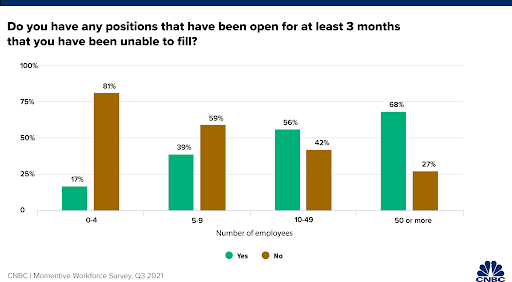Is There Hope for the Labor Market?

Image Courtesy of CNBC
By Chris Carey
The buzzword “jobs” plagues election cycles and pundit analyses, and for good reason. Americans have a vested interest in the workforce and its viability as without regular income provided through work, they are unable to thrive. In an interesting reversal, many economists today predict that due to the coronavirus pandemic’s effect, as well as the generous unemployment provisions in the various relief acts, the labor market might not return to full force for years to come.
Everyday stories of small businesses across the country closing down due to the nationwide labor shortage this summer have painted the situation in a dire light. Small business owners who cannot afford to pay exorbitant wages understood that the weekly $600 unemployment check many lower-income workers capitalized on is much more desirable than working for similar, or even smaller paychecks.
Further, many workers have expressed concern about working service jobs, retail jobs, and in other industries that require face-to-face interaction with many people over the course of a work shift. The coronavirus’ incredible rate of transmissions has deterred many individuals from returning to work even as many COVID-19 relief unemployment benefits expired on September 4, 2021.
Directly looking at the numbers, CNBC reports that “half of small business owners (50%) say it’s gotten harder to find qualified people to hire compared to a year ago,” while “almost one-third (31%) say they have open roles they have not been able to fill for at least three months, up from 24% last quarter and 16% in Q1 2020.”
Evidently, the difficulties faced by businesses are not solely anecdotal in nature. Although over half of the United States population is fully vaccinated, many states are well below that threshold while simultaneously rolling back regulations on masks, distancing, and occupancy indoors. For those same retail and personnel staffers, there is even less incentive to return to a workplace that might not guarantee physical safety at a rate that convinces an employee he or she is better at work than at home.
This stress to compensate workers additionally for the situational difficulties of working during the ongoing pandemic and delta variant can also be found in the numbers. According to a survey conducted in August of 2021 by CNBC, “the labor situation has resulted in 41% of small business owners saying they are currently experiencing a rising cost in wages.” As it becomes more difficult to retain labor, businesses feel the need to increase wages which has a chain-like effect on consumer prices and the market as a whole.
Regarding the longer lasting effects of the imbalance in the labor market, there will be increased wages and limited staffing for years to come. For the few individuals searching for work, there is much competition for their time that is reflected in wages and other incentives.
CNBC also reports that “32% of small business owners say they have raised wages in the past three months to attract workers, while 27% have offered more flexible hours, and 24% more on-the-job training.” These draining and long-term costs on businesses require that the business owners make decisions on reducing staff or eating the labor costs that were not previously necessary.
Without an external shock, the labor market will take considerable time to equalize, vastly impacting the small businesses across the country, prices in their respective markets, and the labor force of the nation.





